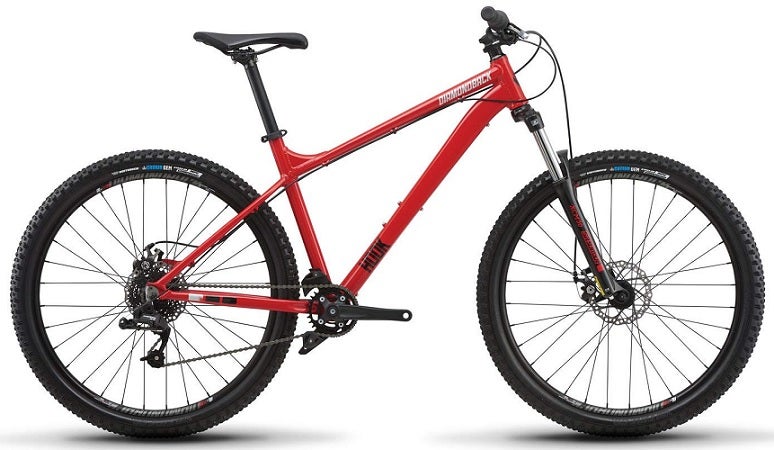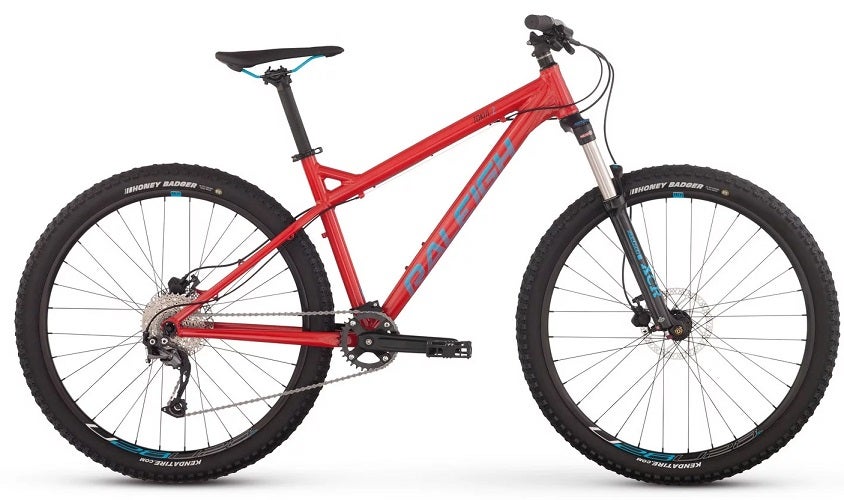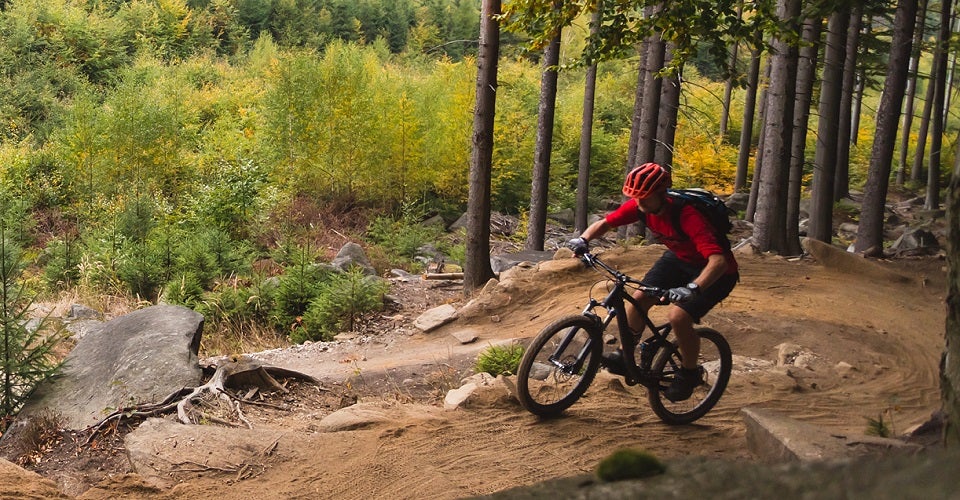
Our Editors independently research, test, and rate what we feel are the best products. We use affiliate links and may receive a small commission on purchases.
When beginning your search for the best beginner mountain bike for you, don’t be fooled by the photos you will see advertising mountain bikes, it is not all about huge jumps and drops at breakneck speed. Mountain biking is also a great way to enjoy nature and build fitness.
When you start off, you can still enjoy mountain biking by staying on easier trails and increasing the difficulty as you gain experience.
To get started, you should read this beginner’s guide to mountain biking to get a better idea about the sport. You will find all sorts of information about different bike types and the clothing that will keep you comfortable.
The big question is about the bike: What is the best beginner mountain bike?
Obviously, this is a serious consideration because you certainly want to get a capable machine but at the same time, you might not be comfortable shelling out lots of money for a top-of-the-line mountain bike when you’re new to the sport. If you are ready to dive into the deep end, check out our recommendations of the best enduro bikes.
Looking for a different type of bike? Read our comprehensive guide to every type of bicycle.
The Best Mountain Bikes For Beginners
| Diamondback Bicycles Hook Hardtail | Santa Cruz Bicycles Chameleon | Kona Satori SE 29 | |
|---|---|---|---|
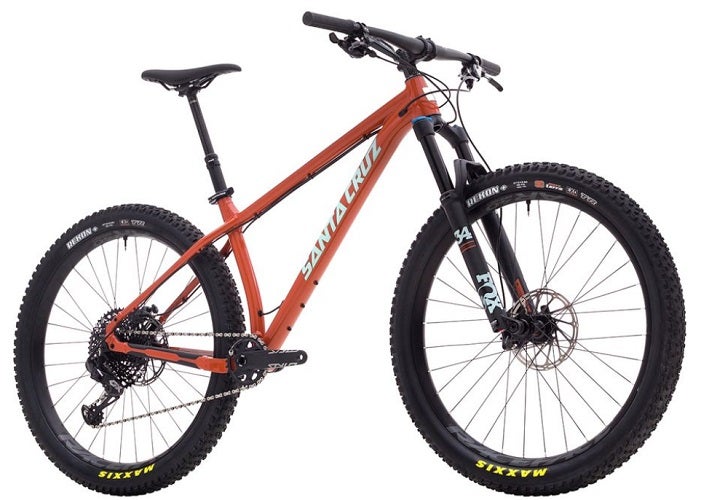 | 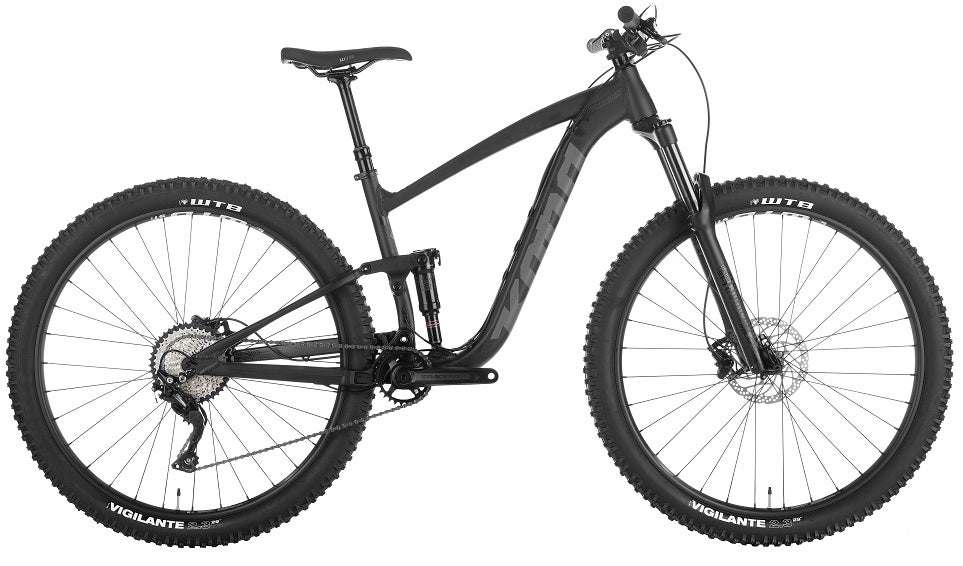 |
||
| Frame: | 6061-T6 aluminum alloy frame | Series 2 6061 Aluminum | Kona 6061 Aluminum Butted |
| Tires: | Schwalbe Tough Tom 27.5×2.35″ | Maxxis Minion DHF 3C EXO, 29 x 2.3“ | WTB Vigilante, 29 x 2.3″ |
| Drivetrain: | SRAM 1×11 speed | SRAM XG1275 Eagle (12-speed), 11-50T | Shimano Deore, 11-42T, 12spd |
| Brakes: | Tektro Aries mechanical disc brakes with 180 front/160mm rear rotors | SRAM Level TL | Shimano MT401 Hydraulic |
| Shocks: | SR Suntour XCR 120mm travel | FOX Float 34, 120mm Travel | RockShox Recon RL Solo Air, 140mm, RockShox RL DebonAir (rear) |
| Weight: | 31 lbs | N/A | 29.2 lbs |
| Competative Cyclist | JensonUSA |
For more of my MTB gear recommendations, have a look through these popular Outside Pursuits guide links: MTB Pedals, MTB Helmets, MTB Shoes.
Quick Answer: The 5 Best Rated Mountain Bikes For Beginners
- Diamondback Bicycles Hook Mountain Bike
- Santa Cruz Chameleon Mountain Bike
- Kona Process 153 Mountain Bike
- Raleigh Bicycles Tokul Hardtail MTB
- Orbea Laufey H30 Bike
Our reviews of the top rated beginner mountain bikes with our guide and comparison table will help you choose the right one for you.
Beginner Mountain Bike Reviews
#1 Diamondback Bicycles Hook Hardtail Mountain Bike
With its modern frame geometry and great price, the Diamondback Line is our Editor’s Choice for the best beginner mountain bike. As you can probably see, it’s a hardtail with a low bottom bracket height and length of the frame allow you to ride fast through rough terrain while the rear triangle is kept short to give the ride a playful feel. Designed to be a do-it-all hardtail, you will be able to get all the basics of mountain biking mastered on the Line. The SR Suntour XCR fork with 120mm of travel is an excellent choice for a bike at this price range. You may not get the impeccable performance of forks that cost more than this whole bike, but you do get a fork that can hold its own on rough trails. SR Suntour forks are present on the majority of entry level mountain bikes not only because they are affordable, but also because they are reliable and can be trusted to get the job done. The XCR has 32mm wide stanchions (legs) to boost stiffness and you can set the preload or even lock out the fork for climbs. It does struggle a bit with big hits and really chunky rock gardens but you will need to learn the skills to deal with those on smaller features first before this becomes a concern. A SRAM 1×8 drivetrain gives you an acceptable range of gears. This should just about be enough range for you to enjoy a ride. If you have lots of steep hills in your area, you may want to try out some smaller chainring sizes to help you get up them, but this will come at the expense of a slower top speed. Consider upgrading to 1×10 at some point. The Hook rolls on 27.5” wheels and the chunky, knobbly 2.35” Schwalbe Tough Tom tires have got your back through any terrain, including mud. When it is time to slow down, Tektro Auriga hydraulic disc brakes are there for you. These are very much entry level brakes and do not offer too much power or control. They will still be able to stop you though, and they can certainly stop you better than any mechanical brake. For beginner purposes they are absolutely fine. Despite the modern geometry of the frame, it is surprising to see a non-tapered headtube. Most modern frames use this wider design and matching fork for stiffness. At the beginner level you do not really need to worry about the difference in performance but the presence of a non-tapered headtube dramatically limits your fork upgrade options in the future. As a result, when you feel that you have reached the limits of the Line in its current build, you will have to purchase a whole new bike to get something with better suspension. Despite this, the Line is still an excellent choice as the best entry level mountain bike you can buy in it’s price range! You will not be disappointed with its performance and it will provide the platform you need to dive into proper trails and get to grips with mountain biking.
FRAME
SHOCKS & SUSPENSION
DRIVETRAIN
WHEELS
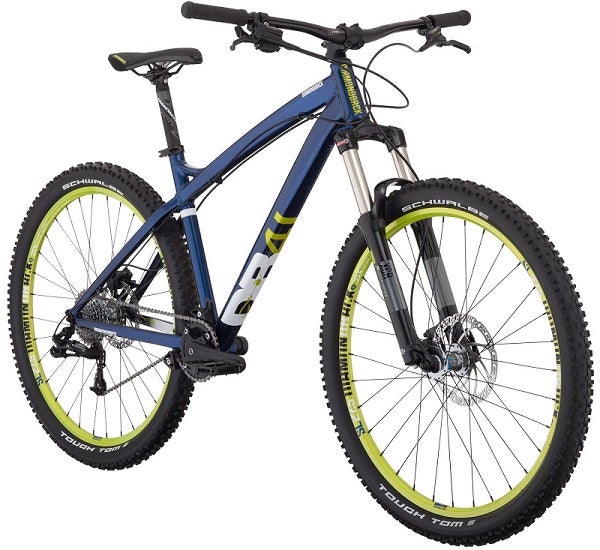
HEADTUBE
#2 Best Mountain Bike You Won’t Outgrow – Santa Cruz Bicycles Chameleon Mountain Bike
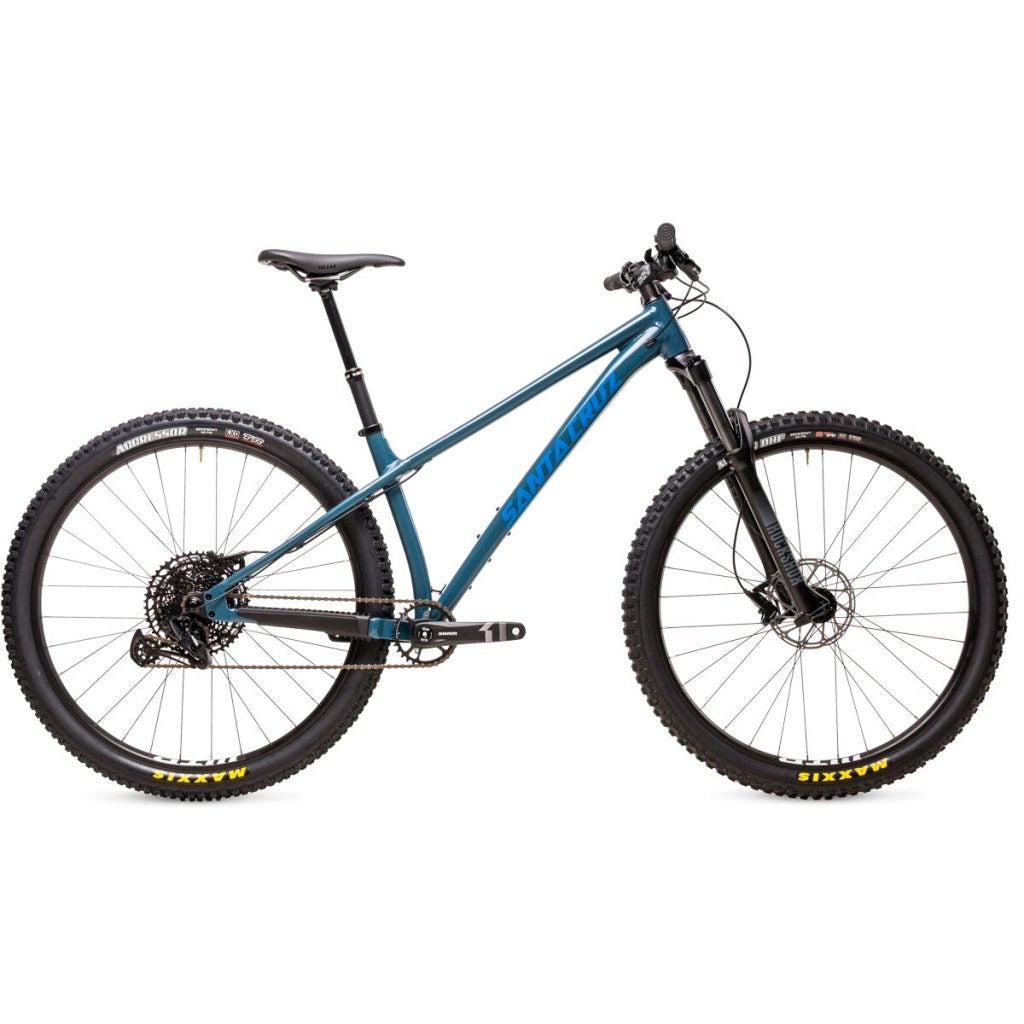
- Frame: Aluminum
- Tires: Tubeless-Ready Maxxis Tires
- Drivetrain: SRAM NX and SX Eagle 1×12 drivetrain
- Brakes: SRAM Level TL
- Suspension: 130mm RockShox Recon RL Fork
The Santa Cruz Chameleon is the best beginner mountain bike for riders who want to buy one bike that they can ride without worrying about outgrowing it as their skills progress. Now in its eighth generation, the Chameleon features modern trail geometry with a long front center and slack head angle that increases rider confidence as speeds pick up and the trail gets steep. This isn’t just a bike for beginners, this hardtail can keep pace with many full-suspension models making it a great option for any mountain biker who wants a trail-ready bike that won’t break the bank.
FRAME
One reason for the Santa Cruz’s popularity is the strong frame design. Obviously, Santa Cruz has obviously made changes to the frame over the years. Originally it was only available for 26” wheels (as all mountain bikes were back then).
Now it is available with 29-inch wheels and with modern frame standards like a tapered head tube and wider axles. All of the fun and reliable aspects of the original remain.
This 29-inch version is the perfect beginner mountain bike if you think your riding will tend more towards all-day adventures rather than cross-country racing.
SHOCKS
Softening the front end is a RockShox Recon RL fork with 130mm of travel. While it will do its best to deal with big hits or even the odd drop, it is not really intended for such maneuvers. If you want to get to grips with the airborne side of mountain biking, then you should look elsewhere and also for a bike more intended for gravity.
DRIVETRAIN
To help take you up and down mountains all day long, the Chameleon has an entry-level SRAM 1×12 drivetrain. Accurate shifting is what you should expect from any modern drivetrain and you get exactly that.
WHEELS
The stock wheelset and Maxxis tires are tubeless-ready, meaning you can easily drop a bit of weight and increase flat resistance by converting to tubeless.
Many years later, the Chameleon retains all the reasons why it became the best starter mountain bike! Now available with 29” wheels, you do not need to look any further for a beginner mountain bike to take you on big adventures in the hills.
#3 Kona Satori SE 29 Mountain Bike
- Frame: Kona 6061 Aluminum Butted
- Tires: WTB Vigilante, 29 x 2.3″
- Drivetrain: Shimano Deore, 11-42T, 12spd
- Brakes: Shimano MT401 Hydraulic
- Shocks: RockShox Recon RL Solo Air, 140mm, RockShox RL DebonAir (rear)
- Weight: 29.2 lbs
Getting into the world of serious mountain bikes for hardcore riding, the Kona Satori SE is the little brother of the Process series. While the Satori SE may have a bit less focus on hardcore gravity riding, it retains the same trail shredding capability of its brethren.
FRAME
The frame cuts a similar shape to the Kona Process frame. There is lots of standover height to help you move around with a long reach and a slack head angle.
In terms of weight, the Satori SE is avg weight at 29.2 lbs but Kona are so confident about the strength of the frame that it comes with a lifetime warranty.
Although Kona would more than welcome you to take the Satori to an enduro race, as a beginner, you are unlikely to do so. What you need to think about at this stage is how a bike can support you while you get used to mountain biking and learn the basic to intermediate skills.
The Satori SE definitely has your back. It climbs well and the shock has a lock out setting to stiffen it up on big climbs.
Open up the suspension before pointing the Satori downhill and you will find yourself on board a confident bike that begs you to push it harder.
SHOCKS & SUSPENSION
The RockShox Recon RL Fork and RL DebonAir rear shock make small work of trail chatter, as well as bigger impacts, such as through rock gardens or drops.
A disconcerting wheezing sound does come from the fork when it compresses and rebounds, but this is nothing to worry about.
DRIVETRAIN
A Shimano Deore is one of the factors keeping the price of the Satori SE low. While this gives you all the range that you need, even for big days in the mountains, it is heavier than many setups.
On an already heavy bike, you may want to keep an eye on your savings and upgrade at some point in the future.
WHEELS
The Satori SE rolls on WTB rims laced to Shimano Deore hubs. WTB Vigilante tires perform very well in all conditions, except deep mud. You will enjoy the confidence and traction that these tires give you.
In keeping with the Satori’s trail shredding attitude, it comes fitted with a TranzX dropper post. Although the 140mm of travel is certainly welcome when you want to get the seat out of the way for hectic descents, unless you are short, you will find the seat still quite high.
Again, a dropper post with more travel is an upgrade you can make in the future.
Out of the box, the Kona Satori SE is the perfect full suspension trail bike that will not break the bank. It will flawlessly accompany you on any mountain bike missions you take it on, whether that is big mountain adventures or learning new skills at the bike park.
While it is more than capable in this set up, once you have progressed as a rider and want to start making upgrades, the frame will still be there for you, always prepared to help you take your riding to the next level.
While its a little more expensive than the other bikes on our list, if you want the best mountain bike for beginners, the Kona Satori SE is for you!
#4 Raleigh Bicycles Tokul Hardtail Mountain Bike
- Frame: AL-6061 SL Aluminum
- Tires: Kenda Honey Badger 27.5 x 2.2
- Drivetrain: Shimano 12-36t, 9spd
- Brakes: Tektro Auriga Hydraulic Disc, 160mm rotors
- Shocks: SR Suntour XCR 32 Coil, 120mm
- Weight: 30 lbs
Raleigh produce all manner of affordable yet capable bicycles across all genres of the sport. It is no surprise that they released this alloy version of the Tekoa 2 to complement the earlier carbon frame model.
To keep the final price of their bikes down, Raleigh design and build as some components themselves.
DRIVETRAIN
Despite this, it is still a surprise to see a Shimano 12-36t, 9 Speed Cassette on the Tokul 2, giving you all the gears you need for big days in the mountains as well as reliable and accurate shifting.
WHEELS
The 2.2 tires do a great job of absorbing small bumps and minor trail chatter. They also give incredible traction when climbing and have grip for days when hammering downhill. Anything that gets past the tires is left to the SR Suntour XCR fork.
SHOCKS & SUSPENSION
This 120mm travel fork is designed for cross country racing. It therefore performs well when both climbing and descending, as long as you do not throw anything too extreme at it, which you are unlikely to do at the beginner level anyway.
The Suntour XCR also has a remote lock out so you can climb with even more efficiency.
BRAKES
Tektro Auriga also take care of the braking with their impressive brakes. These hydraulic disc brakes feature all the important internal aspects of their bigger brothers to give you huge braking power and modulation.
The Tektro Auriga feature reach adjust (how far the lever sits from the handlebar), so you can dial them in to your hand size, albeit with a tool so you cannot do so on the fly.
FRAME
At the heart of any bike is the frame and the Tokul 2 does not disappoint. The long reach may feel stretched out to some but helps you when climbing and the length of the bike gives stability at speed.
The head tube is tapered and the rear axle is wide and stiff, following the 12×142 standard.
The only disadvantage of the bike is that the wheel hubs have unsealed bearings, so will not last as long if you regularly ride in wet and muddy conditions.
Overall, the Tokul 2 is a highly capable plus sized bike at a more than affordable price point. The tires add a level of comfort and confidence with their bump absorbing properties and grip.
#5 Orbea Laufey H30 Beginner Mountain Bike
- Frame: Orbea MX Aluminum Alloy
- Tires: Maxxis Rekon 2.6″ x 29“ 60 TPI Exo TLR
- Drivetrain: Sun Race 11-46t 11-Speed
- Brakes: Shimano MT201 Hydraulic Disc
- Shocks: RockShox Recon RL 140 Air Q15x110 Boost
- Weight: N/A
Spanish brand Orbea have built the MX 29 to be a shapeshifting hardcore hardtail for trail riding.
Why shapeshifting?
The Orbea MXcomes with 29″ tires but can also accept accept 27.5” wheels with plus sized tires.
Each of these set ups will give you a different ride and different types of chaos…good chaos though!
FRAME
Modern geometry such as a slack head angle and short chainstays ensure that you have confidence on steep or rough descents. With big plus sized tires, the Laufey is certainly not a light bike to ride, but it does not want or need to be a featherweight race machine.
What it wants to be is a tough machine capable of taking a hammering. And this is exactly what it is with a huge portion of fun thrown in.
SHOCKS & SUSPENSION
Up front you get 140mm of travel from the RockShox Recon RL with boost axle spacing for stiffness. This fork will eat up the big and small hits flawlessly, albeit with a bit of flex in the stanchions.
A lock out lever means you can stiffen the fork up for climbs before opening it again to enjoy the descent.
DRIVETRAIN
Orbea spec the Laufey with a 1×11 drivetrain on a Shimano SLX and 36-tooth chainring. Beginners or anyone in areas with steep climbs may find this chainring a bit too big so consider changing to a 30-tooth until your legs get stronger.
WHEELS
Strong Orbea Tryp 30c rims spin on Modus boost hubs to keep the MX rolling on a stiff and strong platform. The Maxxis Rekon 2.60″ tires have huge amounts of grip and comfort once you have found your perfect pressure.
You will almost certainly need to invest a fair bit of time to find the right tire pressure, but once you have found it, you will absolutely love the feel of these beasts.
BRAKES
Stopping duties are taken care of by Shimano MT201 Hydraulic Disc brakes. Thanks to trickle down technology from more expensive brake models, the MT200s can provide you with all the braking power and performance that you need.
There is also reach adjust to dial in the lever position to match your hand size.
Giving the bike a clean look is the internal cable routing to keep the cables out of site. There is even internal routing for a dropper post, which would make a great upgrade to the stock post.
The Laufey wants you to squeeze as much fun as possible out of each trail you take it on. At the end of the day, regardless of any other motivations you have for getting into mountain biking, fun is probably on the list.
So if you want the best value mountain bike in a plus sized hardtail that is guaranteed to give a good day on the mountain, then get yourself a Laufey !
Beginner Mountain Bike Comparison Table
| Frame | Tires | Drivetrain | Brakes | Shocks | Weight | ||
|---|---|---|---|---|---|---|---|
| Diamondback Bicycles Hook Hardtail | 6061-T6 aluminum alloy frame | Schwalbe Tough Tom 27.5×2.35″ | SRAM 1×11 speed | Tektro Aries mechanical disc brakes with 180 front/160mm rear rotors | SR Suntour XCR 120mm travel | 31 lbs | |
| Santa Cruz Bicycles Chameleon MTB |  | Series 2 6061 Aluminum | Maxxis Minion DHF 3C EXO, 29 x 2.3“ | SRAM XG1275 Eagle (12-speed), 11-50T | SRAM Level TL | FOX Float 34, 120mm Travel | N/A |
| Kona Satori SE 29 |  | Kona 6061 Aluminum Butted | WTB Vigilante, 29 x 2.3″ | Shimano Deore, 11-42T, 12spd | Shimano MT401 Hydraulic | RockShox Recon RL Solo Air, 140mm, RockShox RL DebonAir (rear) | 29.2 lbs |
| Raleigh Bicycles Tokul Hardtail | AL-6061 SL Aluminum | Kenda Honey Badger 27.5 x 2.2 | Shimano 12-36t, 9spd | Tektro Auriga Hydraulic Disc, 160mm rotors | SR Suntour XCR 32 Coil, 120mm | 30 lbs | |
| Orbea Laufey H30 Beginner | 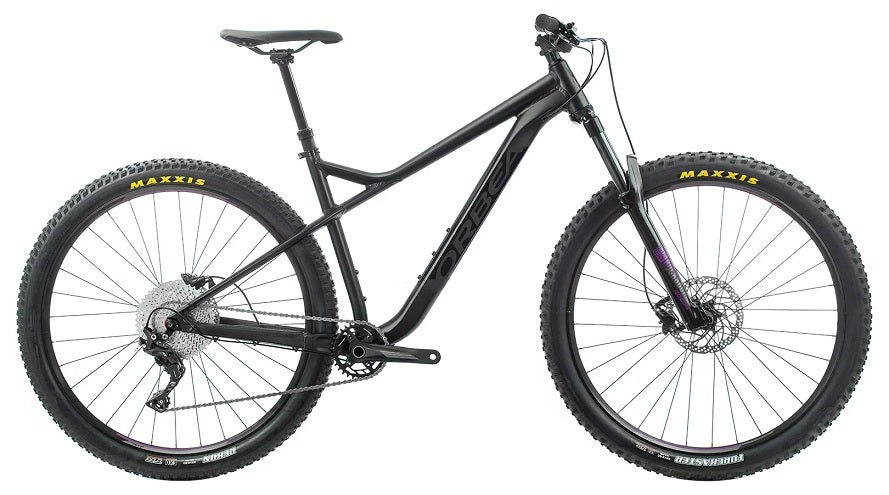 | Orbea MX Aluminum Alloy | Maxxis Rekon 2.6″ x 29“ 60 TPI Exo TLR | Sun Race 11-46t 11-Speed | Shimano MT201 Hydraulic Disc | RockShox Recon RL 140 Air Q15x110 Boost | N/A |
How to Choose the Best Beginner Mountain Bike
- Choosing the Right Mountain Bike
- Hardtail or Full Suspension?
- Frame Material
- Wheel Size
- Drivetrain
- Brakes
- Tires
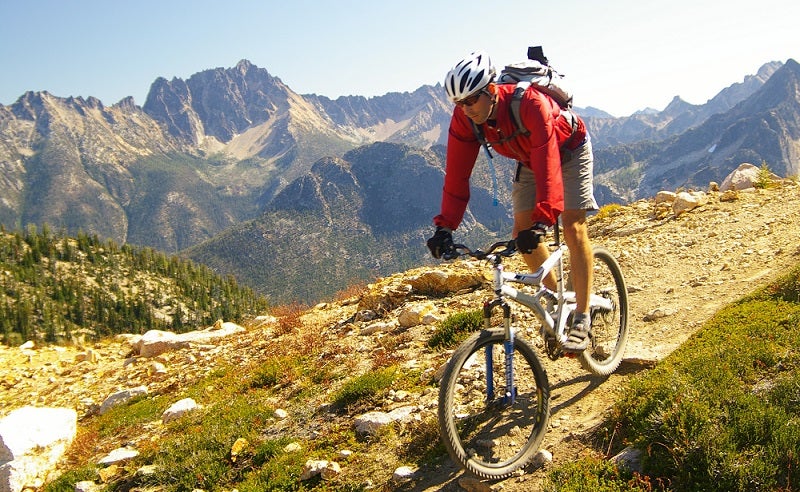
Choosing the Right Beginner Mountain Bike
Hopefully by now you have tried out mountain biking a few times with friends. If not, it is advisable to give it a go before purchasing your own mountain bike, just to make sure that you are committed before spending money.
Once you have made that decision, you may be wondering where to start and asking yourself questions like which bike should you buy and what clothes do you need. We are here to help with all of the questions you might have!
Most people will want to start with something more affordable that is more matched to the kind of trails that beginners will typically start on.
At the end of the day, you do not need a long travel race machine if you are not going to ride the advanced trails it has been built for. It is better to master the basics on a capable yet affordable bike and upgrade later.
So with that in mind, here are a few things that you should consider and look out for when buying a beginner mountain bike.
Hardtail or Full Suspension?

Hardtail mountain bikes have a suspension fork at the front and a rigid rear end. Full suspension bikes have a shock at the rear as well as a suspension fork.
Which is better?
Neither is necessarily better. Having suspension at the back means you have better traction but less efficiency when pedaling. Hardtails are lighter and cheaper due to the simpler frame design and lack of shock.
So which should you go for? A hardtail will certainly get the job done but you will enjoy a bit more comfort on a full suspension bike.
One thing you should be wary of is the actual fork and shock used. There is a world of difference between a good quality fork/shock and a cheap version.
The former will give you a comfortable ride and enhance your performance whereas the latter could just behave like a pogo stick and cause you problems. The mere presence of suspension on a bike does not automatically mean it is good.
Frame Material
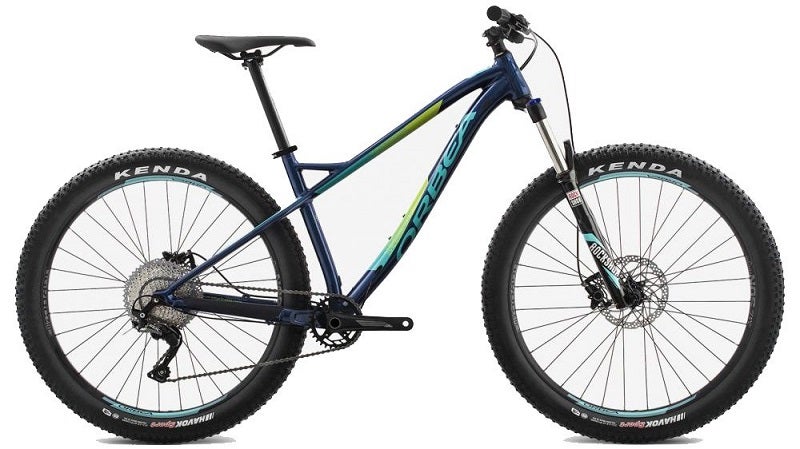
There are three materials commonly used for modern mountain bike frames: aluminum alloy, carbon or steel. An affordable beginner mountain bike is unlikely to have a carbon or steel frame.
Carbon is expensive to produce and steel is generally used on custom or boutique bikes.
Wheel Size
26” wheels used to be the standard but there are very few new bikes being made with this wheel size. It has been replaced with 27.5” and 29” wheels.
A bigger wheel can roll easier over obstacles on the trail, carries speed better but accelerates slower than a smaller wheel. Acceleration speed should be of no concern to you as a beginner but the advantages of a big wheel definitely should be.
The choice between the sizes will come down to your height. Taller riders often feel more at home on a 29 inch.
Drivetrain
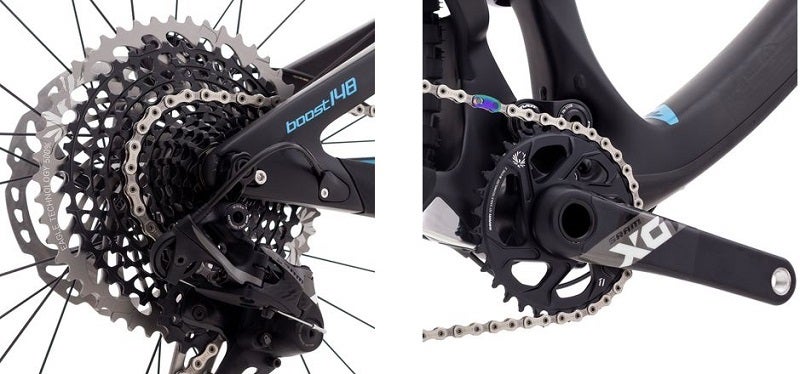
On beginner mountain bikes you can expect to see drivetrains with 2 chainrings at the front and a 9, 10, or 11 speed cassette (2×9, 2×10, 2×11). If you are lucky, you will find one with a 1×10 or ideally a 1×11 set up.
A single chainring paired with a 10 or 11 speed cassette will give you the range of gears you need with less weight than a 2x set up (less chainrings, one less gear shifter and no front derailleur or extra cables).
Brakes
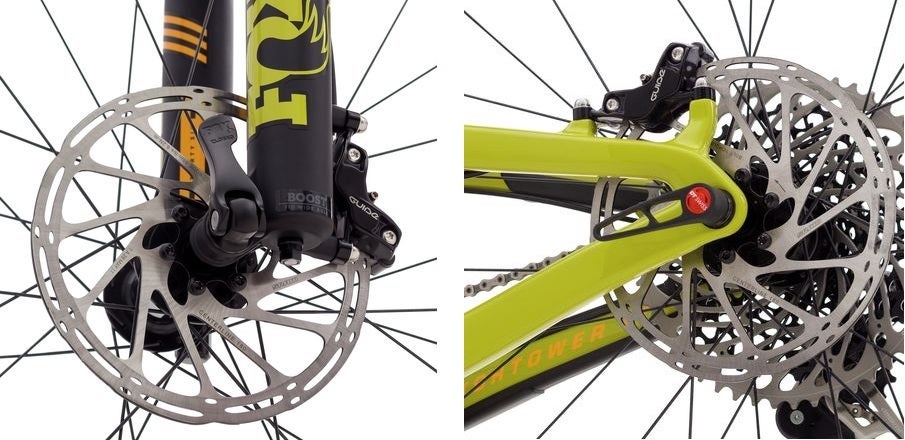
To enjoy mountain biking, we recommend you settle for nothing less than hydraulic disc brakes. The difference in braking power and performance in comparison to cable pull or rim brakes is huge.
An affordable mountain bike will not have the best brakes, but as long as they are hydraulic disc brakes, you will be able to stop with ease and comfort.
If you are looking at a bike that does not have disc brakes, check to see if the hubs, fork and frame are compatible and consider purchasing a set to fit to your new bike.
Tires
Do not expect too much from the stock tires on beginner mountain bikes. They are likely to be cheap and use hard compound to keep the price of the bike down.
Tires have a profound effect on the handling of a mountain bike, so an upgrade to a set of tires suited to mountain biking is highly recommended.
I hope this guide was helpful in picking the best beginner mountain bike to fit your needs. If you want to comment or recommend a bike I didn’t include, please use my contact form to get in touch.
Have fun and be safe out there!
How We Researched
To come up with the top mountain bikes for beginners, we researched a variety of sources for reviews such as Competitivecyclist, JensenUSA, REI, EVO along with our own personal experience.
We also consulted online magazines for product research and reviews to get as much unbiased information as we could. To help weed out fake reviews we used Fakespot.com to make sure we only looked at genuine reviews.
With so much quality gear available, we had to narrow it down based on what we felt were the best options were for the price. The author, Richard Bailey has a wide background in mountain biking in a variety of countries, terrain types and bike packing for weeks on end.
The author has decades of experience and is eager to share his knowledge with readers.
To help narrow down the selection we used personal experiences along with recommendations from fellow MTB bikers, bloggers and bike shops.
After extensive research, we came up with our list to help you choose the right one for you.

